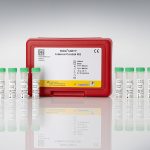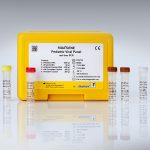Intended use:
For in vitro diagnostic use. The RIDA®UNITY EHEC/EPEC test, performed on the RIDA®UNITY platform, is a multiplex real-time PCR for the direct qualitative detection of DNA for virulence factors of EHEC, STEC, EPEC, and EIEC/Shigella spp. in untreated human stool samples and culture samples from people with signs and symptoms of acute gastroenteritis.
The RIDA®UNITY EHEC/EPEC test is intended to support the differential diagnosis of E. coli infections (EHEC, EPEC, STEC, and EIEC/Shigella spp.) in patients with symptoms of gastroenteritis in conjunction with other clinical and laboratory findings.
Negative results do not rule out infection with E. coli (EHEC, EPEC, STEC, or EIEC/Shigella spp.) and should not be used as the sole basis for diagnosis.
The product is intended for professional use.
General information:
Diarrheal illnesses are a significant health problem, causing approximately 1.7 billion cases per year in children worldwide. According to the World Health Organization (WHO), with approximately 525,000 deaths per year, these illnesses are the second leading cause of death in children under the age of 5, especially in developing countries. One of the most common bacterial pathogens of diarrheal disease is Escherichia coli.
E. coli is a Gram-negative, lactose-fermenting, motile bacterium and belongs to the family Enterobacteriaceae. It is a normal inhabitant of the gastrointestinal tract, but can also cause diarrheal diseases with high morbidity and mortality in children, especially in developing countries. The following classes of diarrheagenic E. coli were identified based on the bacterium’s virulence characteristics, epidemiology, and clinical manifestations: enteropathogenic E. coli (EPEC), enterotoxigenic E. coli (ETEC), enterohemorrhagic E. coli (EHEC), enteroinvasive E. coli (EIEC), and enteroaggregative E. coli (EAEC). All of these diarrheagenic pathotypes of E. coli can be transmitted via the fecal-oral route.
Among the intestinal pathogenic E. coli, the enterohemorrhagic E. coli (EHEC) have gained special importance. They are a subgroup of the Shiga toxin- or verotoxin-producing E. coli (STEC and VTEC, respectively). The pathogenicity of STEC can be traced to their ability to colonize the intestine by adhering to the intestinal epithelial cells. After colonization, the bacteria are able to produce two cytotoxins: verotoxin 1 and 2. Owing to the similarity of the verotoxins to the Shiga toxin of Shigella dysenteriae, VTEC are also called STEC. Other important diagnostic EHEC pathogenicity factors are not only stx1/stx2 (Shiga toxin genes), but also the eae gene (E. coli attaching and effacing gene), which encodes intimin, the membrane protein. This membrane protein is responsible for the adhering of the pathogen to the intestinal epithelial cells. Clinical symptoms that can be caused by EHEC/STEC in humans range from bloody diarrhea to hemolytic uremic syndrome (HUS). Sources of infection are primarily contaminated foods, whereas fewer than 1000 bacteria are enough to cause an EHEC/STEC infection. The worst food-related outbreak caused by STEC in Germany so far was in 2011. This outbreak resulted in 3816 identified STEC infections and 54 deaths, of which 32 were associated with HUS.
Enteropathogenic E. coli (EPEC) are known as a cause of pediatric diarrheal diseases, especially in developing countries. EPEC can be distinguished from EHEC by the absence of Shiga toxins. The most common symptoms associated with an EPEC infection are watery diarrhea, abdominal pain, nausea, vomiting, and fever, whereas the infectious dose in healthy adults is about 108 organisms.
Enteroinvasive E. coli (EIEC) and Shigella spp. likewise cause diarrheal diseases worldwide, especially in developing countries. They are both Gram-negative bacteria that are biochemically and genetically closely related to one another. The pathogenicity of EIEC and Shigella spp. is based on the plasmid-mediated invasion of intestinal epithelial cells and their destruction. The products of the invasion plasmid antigen H gene (ipaH) are responsible for this process. This gene is relevant for the detection of EIEC/Shigella spp., making it possible to distinguish this pathotype from EHEC. Outbreaks of EIEC/Shigella spp. infections are considered to be mainly caused by food and manifest with diarrhea, abdominal pain, nausea, and fever.
Accessories:
| Art. No. | UN2205 |
|---|---|
| Test format | real-time PCR with 96 reactions |
| Shelf life | 24 month after production |
Dear customers,
we have started to provide the documents for our products in an electronic format. These are the Instructions for Use (IFU), the Safety Data Sheets (SDS) and the Certificate of Analysis (CoA). For batches placed on the market after 01 January 2023, you can find our documents on the eIFU portal eifu.r-biopharm.com.










